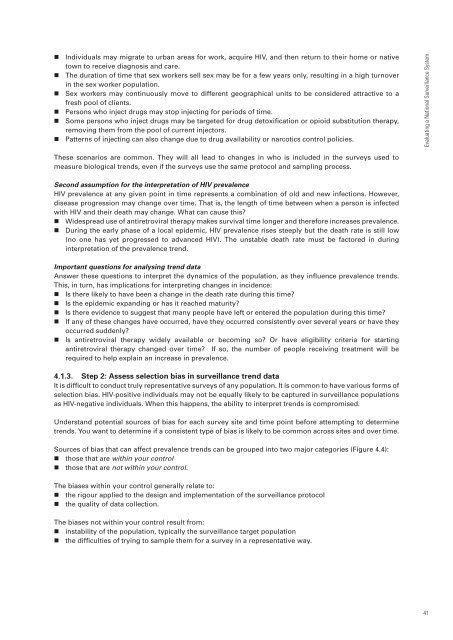Guidelines for second generation HIV surveillance - World Health ...
Guidelines for second generation HIV surveillance - World Health ...
Guidelines for second generation HIV surveillance - World Health ...
You also want an ePaper? Increase the reach of your titles
YUMPU automatically turns print PDFs into web optimized ePapers that Google loves.
• Individuals may migrate to urban areas <strong>for</strong> work, acquire <strong>HIV</strong>, and then return to their home or native<br />
town to receive diagnosis and care.<br />
• The duration of time that sex workers sell sex may be <strong>for</strong> a few years only, resulting in a high turnover<br />
in the sex worker population.<br />
• Sex workers may continuously move to different geographical units to be considered attractive to a<br />
fresh pool of clients.<br />
• Persons who inject drugs may stop injecting <strong>for</strong> periods of time.<br />
• Some persons who inject drugs may be targeted <strong>for</strong> drug detoxification or opioid substitution therapy,<br />
removing them from the pool of current injectors.<br />
• Patterns of injecting can also change due to drug availability or narcotics control policies.<br />
Evaluating a National Surveillance System<br />
These scenarios are common. They will all lead to changes in who is included in the surveys used to<br />
measure biological trends, even if the surveys use the same protocol and sampling process.<br />
Second assumption <strong>for</strong> the interpretation of <strong>HIV</strong> prevalence<br />
<strong>HIV</strong> prevalence at any given point in time represents a combination of old and new infections. However,<br />
disease progression may change over time. That is, the length of time between when a person is infected<br />
with <strong>HIV</strong> and their death may change. What can cause this<br />
• Widespread use of antiretroviral therapy makes survival time longer and there<strong>for</strong>e increases prevalence.<br />
• During the early phase of a local epidemic, <strong>HIV</strong> prevalence rises steeply but the death rate is still low<br />
(no one has yet progressed to advanced <strong>HIV</strong>). The unstable death rate must be factored in during<br />
interpretation of the prevalence trend.<br />
Important questions <strong>for</strong> analysing trend data<br />
Answer these questions to interpret the dynamics of the population, as they influence prevalence trends.<br />
This, in turn, has implications <strong>for</strong> interpreting changes in incidence:<br />
• Is there likely to have been a change in the death rate during this time<br />
• Is the epidemic expanding or has it reached maturity<br />
• Is there evidence to suggest that many people have left or entered the population during this time<br />
• If any of these changes have occurred, have they occurred consistently over several years or have they<br />
occurred suddenly<br />
• Is antiretroviral therapy widely available or becoming so Or have eligibility criteria <strong>for</strong> starting<br />
antiretroviral therapy changed over time If so, the number of people receiving treatment will be<br />
required to help explain an increase in prevalence.<br />
4.1.3. Step 2: Assess selection bias in <strong>surveillance</strong> trend data<br />
It is difficult to conduct truly representative surveys of any population. It is common to have various <strong>for</strong>ms of<br />
selection bias. <strong>HIV</strong>-positive individuals may not be equally likely to be captured in <strong>surveillance</strong> populations<br />
as <strong>HIV</strong>-negative individuals. When this happens, the ability to interpret trends is compromised.<br />
Understand potential sources of bias <strong>for</strong> each survey site and time point be<strong>for</strong>e attempting to determine<br />
trends. You want to determine if a consistent type of bias is likely to be common across sites and over time.<br />
Sources of bias that can affect prevalence trends can be grouped into two major categories (Figure 4.4):<br />
• those that are within your control<br />
• those that are not within your control.<br />
The biases within your control generally relate to:<br />
• the rigour applied to the design and implementation of the <strong>surveillance</strong> protocol<br />
• the quality of data collection.<br />
The biases not within your control result from:<br />
• instability of the population, typically the <strong>surveillance</strong> target population<br />
• the difficulties of trying to sample them <strong>for</strong> a survey in a representative way.<br />
41
















